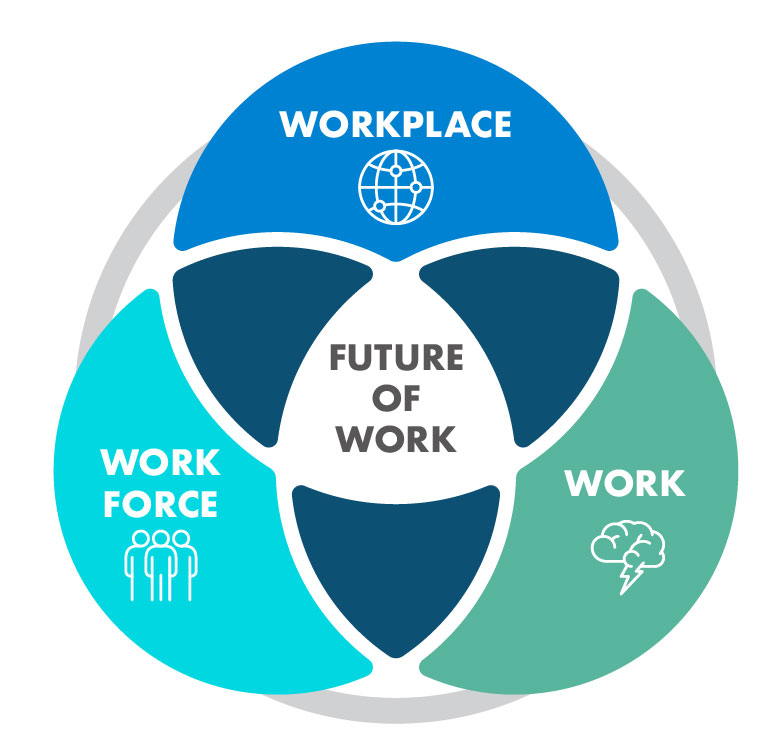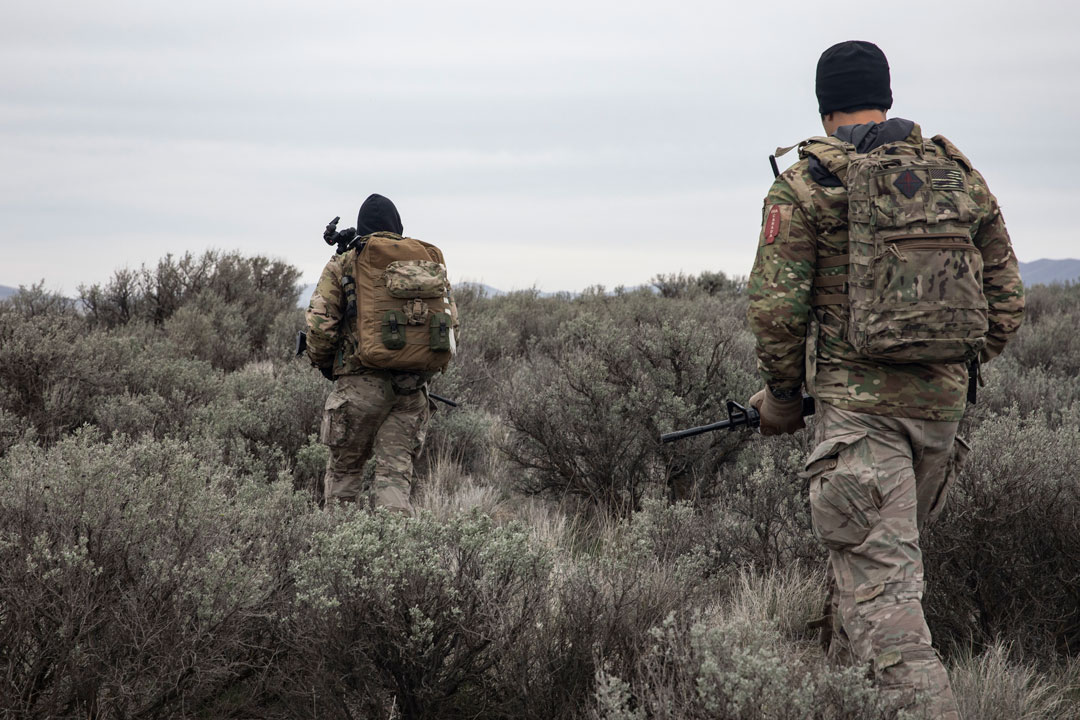
How the Army’s leaders can shape the workplace of tomorrow, starting today.
The 40-hour work week is a relatively new concept in the history of labor and employment, dating back to only 1940. In fact, when the federal government started to study workers’ hours in 1890, the average work week was closer to 100 hours for full-time manufacturing employees. In about 1906, things started to change. First, a few companies in the printing industry instituted eight-hour work days. By 1926, Henry Ford announced a five-day work week for his employees, arguing essentially that workers would spend more money if they just had time to go shopping. When Congress passed the Fair Labor Standards Act in 1938, it was all over but the shouting.
It’s important to keep this history in mind when discussing the so-called “future of work,” a term used to describe how workplaces and the workforce will change over the next several years because of technological, generational and societal shifts. What seems unthinkable today—government agencies getting rid of their cubicles, federal jobs with no “core” work hours, or even having remote access to classified systems for the rank and file—could be the 40-hour work week of tomorrow. The COVID-19 pandemic has dramatically increased the speed at which some of these changes are taking shape, but experts believe that telework and distributed teams are all but certain, regardless.

ALWAYS A STUDENT: In April 2017, Muskopf was enrolled in the Columbia University M.S. in information and knowledge strategy program where she now teaches. (Photo courtesy of Jamie Muskopf)
LOOKING FORWARD
Jamie Muskopf is an entrepreneur, mentor, podcaster, military spouse, innovation consultant and doctor of social work. She is also a faculty associate at Columbia University, where she co-teaches a graduate class called “Navigating the Future of Work.” Having previously worked as a knowledge management officer for the United States Pacific Fleet, a project manager at Microsoft Military Affairs and a program manager at Defense Acquisition University, she has a firm grasp on the military workforce and culture, as well. In an interview with Army AL&T, she spoke about how the Army can take advantage of its pandemic-related shift to telework, and the leadership skills needed for managing remote teams.
“It’s really interesting, because all the things we talk about in this class are things that actually had to happen because of COVID—the remote teaming, fully virtual companies with employees in different countries, all working on specific tasks together,” she said. The key, she said, is that leaders must be willing to ask questions. A lot of questions.
“Proximity, especially in the military, is where control happens,” she said. “The military is a command-and-control organization, so how do we pivot to what is now this very dispersed workforce, if we are going to be working with people remotely? What does leadership look like in a remote workforce? What do meetings look like? Do we have meetings? What do efficiencies look like and what are the focus points? How do you measure what’s getting done? And how do you measure people, when it comes time to evaluate them? And what’s worth measuring, anyway?” Don’t worry. Muskopf said that the emphasis should be on asking the questions—no one expects you to have all of those answers today.

FUTURE OVERLAP: When studying the future of work, it’s important to consider how people, work and technology intersect—changes in the workplace reflect changes in the people, the technology and the work itself. (Graphic by National Institute for Occupational Safety and Health)
LEADING THE CHARGE
For Army leaders, there is much to consider. Muskopf said the starting point should be focusing on the mission first. “The number one thing is obviously the mission at hand. What is it that you need to accomplish? And then thinking, how can you leverage this new opportunity, and you should see it as an opportunity, to have people working flexibly to support that mission,” she said.
“I think most people had a bit of a panic once they realized, ‘Now I have to work remotely. I have to figure out this Teams thing.’ So far so good, right? I mean, things weren’t perfect, but they went pretty well. So now that we have some basic capabilities installed, and we’ve learned some things from the pandemic, including what went right. How do we take those lessons learned and make this even better?”
The next step, Muskopf said, is for leaders to check in with their people. “We can talk about the processes and infrastructures and technologies we need to keep doing our work, but I don’t think enough people are talking about how people are doing with regard to COVID. It’s a stressful time for everyone, but certainly for people in the military environment.”
What would she ask? “The first question is ‘How are you all doing?’ And genuinely caring about and listening to what they say, not needing to respond or fix. Just listen. And then, ‘How do you think we are doing right now as an organization?’ Whether it’s a small organization that you’re leading or any part of the larger whole that you want to learn more about. To me, those are the first questions to be asked, and those aren’t always simple questions to answer.”
It can be hard enough to truly understand how your teammates are feeling when you see each other in person on a regular basis. Add to that the complexities of telework, and it would be easy to miss signs of trouble if you didn’t have an established baseline, Muskopf said. That’s why it’s important for leaders to check in with the teams regularly and consistently. “You start to see patterns in your people,” she said. “It’s not about making things better for them, because sometimes you can’t. It’s just about recognizing that they’re human, and that what’s going on in their life is impacting what’s happening at work, and you do your best to make sure that the work environment is a place where they want and feel safe to be.”

CHECK IN: Leaders need to ask how their teams are doing with remote work consistently—and really listen to their answers. (Photo by Getty Images)
A SAFE ENVIRONMENT
Even if leaders ask all the right questions, there is no guarantee that people will be willing to answer them candidly. “It is important for leaders to create an environment where people feel safe to respond to that question with honesty,” she said. There is a long history of stigma associated with mental health or even just stating that there is a problem, she said. “Progress has been made, but that culture goes a long way back. So to me, as a leader, you must create an environment of psychological safety,” she said. “Everyone recognizes that the military operates in ranks and hierarchy, but when it comes time to innovate, when it comes time to really get things done and move the needle, that requires conversations that are more free-flowing, that aren’t organized in order of who is sitting closest to whom in the horseshoe.”
Creating that sense of safety requires a certain amount of vulnerability on the part of leaders, Muskopf said. “As a senior leader in any branch of the military, everybody is looking to you for the answers. But most great leaders are really looking at the people who work for them and relying on the information they provide to make sure that they are making the right decisions.” She said that the best leaders are decisive, able to approach issues collaboratively and understand how to ask the right questions.
“You know, instead of taking a basic answer for ‘Why are we doing things this way?’ they were able to ask why and then continue to ask why, until they really got to the root of the problem.” She said that things will likely be messy as the Army is planning for the future of work, and that’s just part of the process. “Now is not the time for people to be standing on the sidelines criticizing the mess—now is the time for everyone to be in the mess with one another and figuring out together, so that we can move forward in a better way.”

REAL, VIRTUAL WORK: Elyse Merkel, Dion Collins, Ed Carter, Alaina Farooq. Matt Fohner, Kim Yee and Eric Mscicz, clockwise from top left, participated in the Naval Surface Warfare Center, Philadelphia Division virtual event, “Collaboration in a Remote Environment,” on May 25. Panelists shared their experiences with telework, and spoke about collaborating, building and managing teams virtually, communication techniques, virtual meetings, mentorship, technical development and more. (Photo by Brentan Debysingh, Naval Surface Warfare Center Philadelphia Division)
THE SQUAD MENTALITY
For a case study on the importance of effective teamwork and communication, look no further than one of the Army’s smallest and most storied unit types—the special forces team. Soldiers in those units, particularly in combat situations, have to be able to communicate effectively with every other member of the unit, no matter their rank, position or title. If the radios are down and the chopper is not coming, the alternative is not to just sit there and wait. Soldiers have to think on their feet and they must be empowered to create mission success.
So, what is the thing that allows a unit to operate that way? “They have a level of trust that is unmatched. They are vulnerable with one another. They are capable of saying to one another, ‘This isn’t working for me. I can’t do this. I need you to help me. We need to do this together,’ without fear of judgment, and with the expectation that we all need to be honest with one another—or face potentially dire consequences,” she said. Of course, most of the Army’s work doesn’t take place in that extreme environment, but Muskopf said Soldiers and civilians alike can aim to be just as cohesive and effective.
“That takes a lot of self-awareness and self-accountability, and—how many times have you seen the ‘martyr on the mountain,’ you know, that person who will never accept help? ‘I’ve got it.’ But in reality, and in those kinds of teams, you can’t afford to do that. There will be negative repercussions. You have to really know, ‘Here’s what I need help with. Can we do this together? Yes, great, let’s go.’ ”
“So, it’s not the proximity that matters,” Muskopf said. “What are we doing to build the cohesion on teams? Are we looking at team members as people who bring skills, values, ideals, personality traits, into the environment that make the team better? Maybe there’s one person on the team who’s always the comedian, and can make everything light when it needs to be, and maybe there’s one person who’s excellent at organization and keeping everything moving and timely. How do we figure those things out? How can we do that more purposefully? Let’s look at the teams we’re a part of, whether we get to choose the members or not, and figure out those strengths that add value to the team.”

SQUAD GOALS: The ideal remote team would have many of the same traits as a special forces unit with the ability to communicate effectively no matter a person’s rank, position or title. (Photo by Pfc. Thoman Johnson, 1st Special Forces Group)
CONCLUSION
Ultimately, Muskopf believes that the COVID-19 pandemic has created unique opportunities for growth in the federal government and private industry alike. “I used to work with a Navy commander who would say, ‘I really wish we did have an all-stop button that we could press,’ so everything would stop for one day and we could look at what’s going wrong and then figure it out. I feel like COVID, in some respects, was an ‘all-stop’ button.”
“I think most economists and people who study the future of work are sitting back and observing what the chain reaction is going to be, because we still haven’t fully felt the effects of COVID yet, when it comes to all of this,” Muskopf said. “What are remote work and hybrid work doing to us? The good and the bad. I think it will be a very interesting challenge for the Army.”
For more information, go to the Office of Personnel Management’s Future of Work resource page: https://go.usa.gov/xej5A.
Read more about telework in the Summer 2021 Career Navigator article by Jacqueline M. Hames at https://go.usa.gov/xeje4 and learn tips for effective telework at https://go.usa.gov/xejeT.
ELLEN SUMMEY provides contract support to the U. S. Army Acquisition Support Center at Fort Belvoir, Virginia, as a writer and editor for SAIC. She holds an M.A. in human relations from the University of Oklahoma and a B.A. in mass communication from Louisiana State University. She is certified as a Project Management Professional, Change Management Professional and User Experience Manager, and has more than 15 years of communication experience in both the government and commercial sectors.


